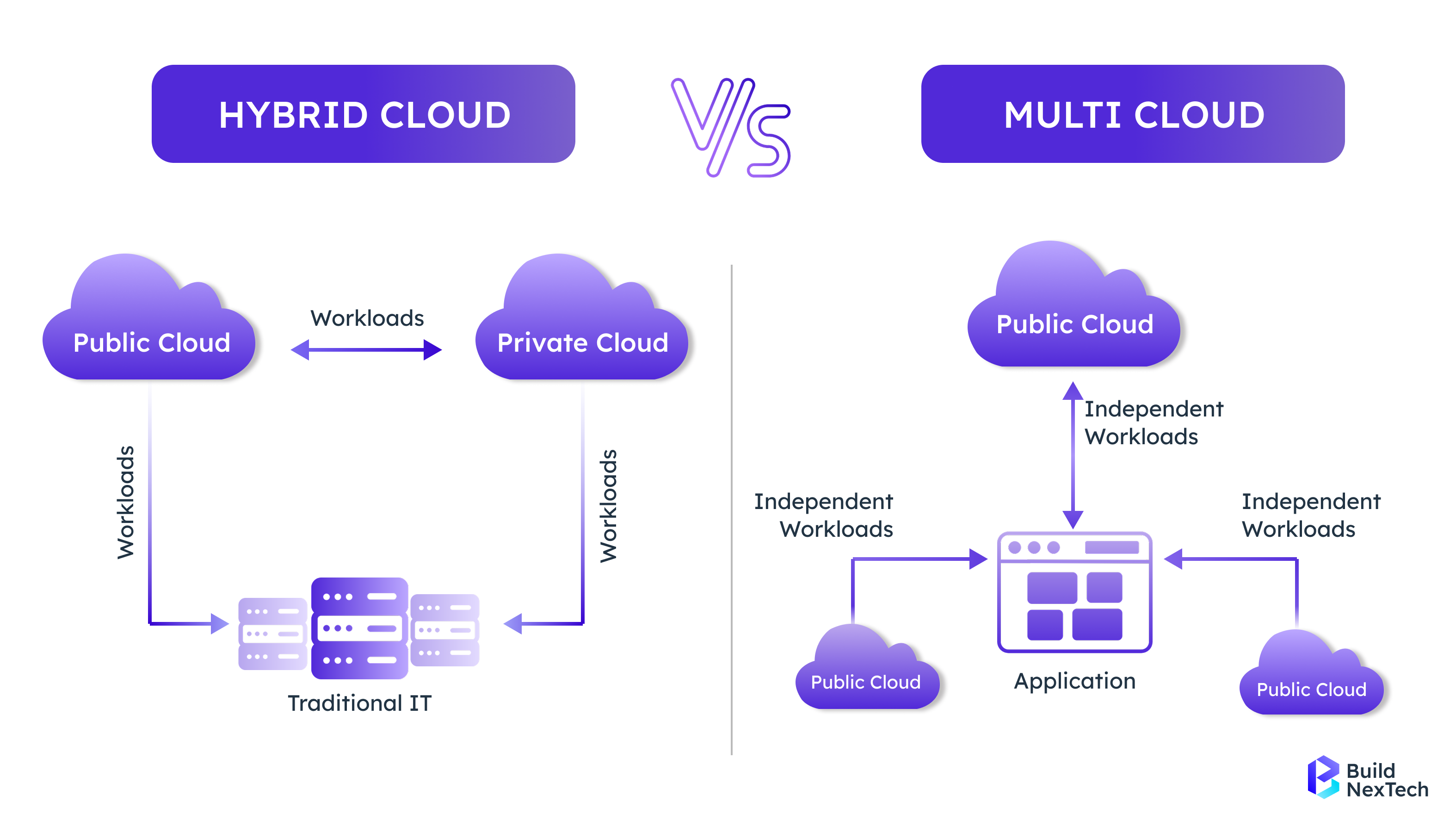In 2025, cloud migration is no longer just an IT upgrade - it’s the backbone of modern digital transformation. As enterprises shift toward multi-cloud and hybrid cloud solutions, managing migration in-house has become more complex, resource-heavy, and time-consuming than ever before. That’s where outsourcing cloud migration comes in - not as a cost-cutting move, but as a strategic accelerator for scalability, resilience, and innovation.
Across industries, businesses are partnering with cloud migration outsourcing companies to move from on-premises to cloud migration and unify their operations across Amazon Web Services (AWS), Microsoft Azure, Google Cloud Platform (GCP), and IBM Cloud. By leveraging specialized cloud providers, organizations achieve seamless integration, cloud security compliance, and efficient cloud management without the operational strain of internal teams.
The rise of multi-cloud strategy and hybrid cloud architectures has reshaped how enterprises manage workloads - combining public cloud agility with private cloud control. Outsourcing ensures these transitions happen smoothly, with experts using proven cloud migration strategies, automation tools, and cloud management platforms to optimize performance and reduce downtime.
In essence, outsourcing cloud migration empowers organizations to:
- Accelerate time-to-cloud while lowering migration risks.
- Adopt multi-cloud management for agility and compliance.
- Balance cost optimization with enterprise-grade security.
- Align with AWS cloud migration experts and hybrid cloud consulting services for scalable growth.
At BNXT, we help enterprises combine the power of outsourcing, cloud infrastructure, and custom web development to build future-ready, scalable ecosystems. Whether it’s cloud data migration, multi-cloud adoption, or enterprise mobile app development services, our approach ensures every migration is secure, seamless, and strategically aligned with business goals.
What Is Cloud Migration Outsourcing and Why It Matters in 2025
By 2025, cloud migration outsourcing has evolved into a cornerstone of enterprise transformation. As businesses manage operations across multi-cloud and hybrid cloud environments, outsourcing has become the bridge between complexity and continuity - helping enterprises move workloads securely from on-premises to cloud infrastructure while minimizing disruption.
At its core, cloud migration means transferring digital assets - applications, data, workloads, and processes - from legacy systems to modern cloud computing platforms. But in practice, this process requires a deep understanding of cloud architecture, cloud management, and cloud security. Outsourcing simplifies this journey by partnering with cloud experts who already possess the experience, frameworks, and automation tools to execute migration efficiently.
Defining Cloud Migration and Its Business Impact
Cloud migration is more than just moving servers - it’s about enabling agility. In the multi-cloud era, businesses use a mix of public cloud (AWS, Azure, Google Cloud) and private cloud environments to balance cost, control, and performance. This cloud adoption strategy allows for flexible scaling and faster innovation cycles.
Outsourcing amplifies these benefits by giving organizations access to cloud providers with proven cloud management platforms and disaster recovery systems. This ensures cloud investments deliver high ROI while freeing internal teams to focus on innovation rather than maintenance.
Multi-Cloud vs Hybrid Cloud - What’s the Difference?
The terms multi-cloud and hybrid cloud are often used interchangeably, but they actually represent different architectural approaches to cloud computing.
A multi-cloud strategy involves using multiple public cloud providers - such as Amazon Web Services (AWS), Microsoft Azure, and Google Cloud Platform (GCP) - to host different workloads or applications. This approach allows organizations to avoid vendor lock-in, optimize performance, and leverage specialized services from each provider based on business needs.
On the other hand, a hybrid cloud model integrates on-premises infrastructure or private cloud systems with public cloud environments, enabling businesses to balance sensitive workloads on private servers while scaling non-sensitive operations on the public cloud. This setup offers greater security control, regulatory compliance, and data sovereignty.
In many modern enterprises, a hybrid multi-cloud strategy emerges - combining the best of both worlds. Here, data and applications can move seamlessly between on-premises systems, private clouds, and multiple public clouds. This ensures higher availability, redundancy, and cost efficiency.
By outsourcing these complex cloud integrations to specialized cloud service providers, organizations gain access to expert knowledge in cloud architecture, interoperability, and management, reducing risks and ensuring smooth, optimized operations across all environments.
How Outsourcing Changes the Cloud Migration Equation
Traditionally, enterprises attempted in-house cloud migration with limited tools and expertise - often facing delays, downtime, and cost overruns. Migration to the cloud changes this dynamic by bringing in specialized partners who:
- Deploy proven cloud migration strategies across AWS Cloud, Microsoft Azure, and Google Cloud.
- Use automated cloud migration tools and Azure Migrate frameworks for precision and speed.
- Ensure cloud security consulting and compliance across industries.
- Leverage AI-driven analytics and Cloud Center of Excellence (CCoE) practices to monitor performance.
The outcome is faster multi-cloud migration, reduced operational risk, and measurable ROI all managed under structured service-level agreements (SLAs).
At BNXT we approach cloud migration outsourcing through a hybrid model - combining automation, strategy, and custom web development to optimize data flow and application performance. Whether it’s cloud-to-cloud migration, cloud data analytics, or enterprise web development services, our focus remains the same: secure, scalable, and intelligent transformation.

Cloud Migration Outsourcing in the Multi-Cloud & Hybrid Context
Enterprises today are moving beyond single-cloud dependency. The new norm is multi-cloud service and hybrid cloud architecture - combining Amazon Web Services (AWS), Google Cloud, Microsoft Azure, and private cloud environments to achieve resilience, performance, and cost optimization.
But with multiple cloud providers, integrations, and compliance layers, the migration journey gets complex. This is where outsourcing cloud migration truly shines - offering structured cloud strategies, cloud management, and cloud security under one unified framework.
Outsourced migration partners don’t just move workloads - they design holistic cloud adoption frameworks, manage governance, and optimize cost-performance balance across hybrid multi-cloud environments.
Seamless Integration Across Public, Private & Hybrid Clouds
A successful cloud migration process hinges on how well different environments connect and communicate.
In a multi-cloud strategy, data might live in Google Cloud Platform, workloads on AWS Cloud, and analytics on Azure Cloud Infrastructure.
Outsourcing providers ensure seamless integration through:
- Cloud management platforms that unify APIs and resources across vendors.
- Cloud architecture design that supports scalability and data interoperability.
- Edge computing setups for latency-sensitive workloads.
- Cloud firewall and cloud security consulting for data protection.
By leveraging cloud experts and automation frameworks like Azure Arc-enabled servers and Azure Edge, outsourced teams reduce migration time and avoid system conflicts - ensuring continuity across the entire cloud ecosystem.
Unified Governance and Data Security Controls
One of the biggest risks in multi-cloud migration is governance fragmentation - multiple vendors, multiple compliance requirements.
Outsourcing solves this by centralizing control through cloud management tools, performance analytics, and cloud compliance frameworks such as HIPAA, ISO 27001, and GDPR.
Key aspects include:
- Implementing identity and access management (IAM) across hybrid setups.
- Creating automated cloud security posture management dashboards.
- Integrating disaster recovery and cloud backup systems.
- Ensuring Cloud Cost Management and audit traceability.
With these practices, outsourced teams build a unified, compliant Cloud Center of Excellence (CCoE) - ensuring governance doesn’t slow innovation.
At BNXT, we embed these controls within our enterprise cloud solutions to balance agility and accountability. This allows enterprises to innovate confidently while maintaining complete data sovereignty.
Cloud-Native Modernization & Application Refactoring
Modern cloud transformation isn’t just about migration - it’s about modernization.
Cloud-native development allows businesses to re-architect legacy systems using microservices, containers, and serverless computing.
Outsourced partners help enterprises adopt cloud-native applications by:
- Rebuilding legacy systems using software as a service (SaaS) models.
- Leveraging Azure Arc-enabled VMware vSphere and Azure Local resources.
- Optimizing cloud data analytics and real-time insights pipelines.
- Using cloud observability tools to ensure visibility and control.
This shift helps enterprises harness multi-cloud management efficiently while scaling their cloud resources dynamically.
It’s not just modernization - it’s future-readiness.

How Outsourcing Improves ROI and Scalability
For most enterprises in 2025, the success of cloud migration isn’t measured by how fast workloads move to the cloud - it’s about how efficiently that move translates into ROI, scalability, and operational resilience.
Outsourcing cloud migration services gives businesses access to global cloud experts, automated cloud strategies, and AI-driven monitoring frameworks that ensure every migration dollar produces measurable value.
Unlike in-house teams, which often juggle multiple projects and outdated infrastructure, outsourced teams deliver predictable OpEx models with faster time-to-market and optimized cloud resources across multi-cloud environments.
Scaling Operations Across Regions with Global Cloud Partners
Enterprises today operate across geographies - managing workloads on AWS Cloud, Microsoft Azure, Google Cloud, and private cloud setups simultaneously.
This complexity can make scaling difficult without a cohesive multi-cloud management strategy.
Outsourcing solves this challenge by offering:
- Cloud-native automation and cloud management platforms that synchronize deployments across public and private clouds.
- On-demand scalability supported by Amazon Web Services, IBM Cloud, and Azure Edge networks.
- Streamlined collaboration between data centers, edge computing nodes, and cloud infrastructure providers.
- Advanced cloud observability tools that provide real-time visibility into performance, security, and costs.
By partnering with multi-cloud experts, organizations reduce dependency on single vendors and improve business continuity even during high-traffic events or regional failures.
This agility translates directly into higher ROI - every new customer interaction, every new region added, becomes an opportunity instead of a risk.
Measuring ROI Through Downtime Reduction & Performance Gains
Cloud migration ROI is not just about cutting costs - it’s about maximizing value creation.
Outsourcing accelerates ROI by reducing downtime, migration errors, and post-deployment inefficiencies through advanced automation and predictive analytics.
Key ROI drivers include:
- Automated workload orchestration powered by cloud-native AI and machine learning models.
- Downtime reduction through pre-migration testing, sandbox simulations, and disaster recovery planning.
- Performance analytics integrated into cloud dashboards for real-time tracking of KPIs.
- Lower maintenance overheads due to Cloud Cost Management and Cloud Optimization Frameworks.
According to a State of the Cloud Report (2025), organizations that outsourced migration saw up to 40% higher cost efficiency and 30% faster cloud adoption rates than those using in-house methods.
At BNXT, we help clients unlock measurable ROI through AI-led migration optimization, hybrid multi-cloud governance, and continuous monitoring frameworks designed to minimize downtime and maximize throughput.
When you blend AWS Cloud Migration Experts, Azure Migrate capabilities, and BNXT’s custom web development strength, the outcome is simple:
📈 Faster scalability, predictable costs, and consistent performance across every cloud layer.
Common Risks and How to Mitigate Them
Even with all its advantages, outsourcing cloud migration isn’t without challenges. Whether you’re managing multi-cloud platforms, hybrid cloud solutions, or AWS cloud migration one misstep can lead to cost overruns, compliance gaps, or downtime.
However, when executed strategically with the right cloud outsourcing partner, these risks can be mitigated - or even turned into competitive advantages.
Here are the most common challenges and how enterprises are addressing them in 2025.
Integration Challenges and Business Continuity
Migrating workloads across public cloud, private cloud, and hybrid environments requires flawless cloud architecture alignment.
In-house teams often struggle with backend integrations, legacy dependencies, or cloud data migration bottlenecks that delay transformation.
Outsourcing mitigates these risks through:
- Pre-migration assessments that identify compatibility gaps early.
- AI-driven orchestration tools ensure smooth migration between Amazon Web Services, Microsoft Azure, and Google Cloud Platform.
- Built-in cloud disaster recovery protocols that secure data and ensure a first-call resolution rate in customer-facing systems.
- Continuous performance analytics to prevent service disruptions post-migration.
Establishing SLAs, Governance, and Cloud Accountability
A successful cloud migration outsourcing project isn’t just about tools - it’s about governance, transparency, and mutual accountability.
When outsourcing to global cloud providers, enterprises must define strong Service Level Agreements (SLAs) that cover:
- Uptime guarantees and response time commitments.
- Data residency and regulatory compliance for industries governed by GDPR, HIPAA, or ISO 27001.
- Cloud security consulting frameworks, including cloud firewall protection and access control policies.
- Clearly defined ownership models for multi-tenant and hybrid workloads.
Well-defined governance ensures that your multi-cloud strategy aligns with long-term goals, balancing agility, performance, and cost.
Top providers now use Cloud Center of Excellence (CCoE) models to monitor KPIs, compliance reports, and ongoing optimization.
BNXT’s approach emphasizes joint accountability - combining AI-driven analytics dashboards, cloud cost management, and continuous SLA monitoring to ensure your hybrid cloud runs like clockwork.
Because when accountability is shared, migration success becomes sustainable.
Choosing the Right Cloud Migration Outsourcing Partner
Selecting the right cloud migration outsourcing partner can define the success of your entire digital transformation.
In today’s multi-cloud and hybrid cloud environments, the partner you choose must be more than just a service vendor - they must act as a strategic cloud advisor, capable of aligning cloud infrastructure, security, and business intelligence with long-term ROI.
The right partner helps balance performance, scalability, and compliance across AWS Cloud Migration, Microsoft Azure, and Google Cloud - while offering custom web development and enterprise mobile app development services that extend cloud capability across your business ecosystem.
Questions to Ask Your Cloud Outsourcing Partner
Before you commit, here are key questions every enterprise should ask a cloud outsourcing company:
- What’s your experience with multi-cloud migration and hybrid architectures?
Look for partners skilled in AWS, Azure, and Google Cloud Platform, capable of managing public, private, and hybrid cloud simultaneously. - Do you follow a Cloud Adoption Framework or Cloud Center of Excellence (CCoE) model?
This ensures continuous governance, SLA tracking, and proactive cloud security compliance. - How do you handle data protection and disaster recovery?
Ensure they provide cloud security consulting, data encryption, disaster recovery automation, and performance analytics dashboards. - What automation and AI tools do you use for cloud migration?
Advanced vendors integrate AI-driven orchestration, cloud-native modernization, and Azure Migrate for speed and accuracy. - Can you support edge computing or cloud-native applications?
The best partners extend your architecture with cloud-native, edge, and multi-cloud management platforms for agility and resilience.
A strong partner will not only answer these but demonstrate a proven track record of delivering scalable multi-cloud strategies, hybrid multi-cloud solutions, and continuous cloud cost management improvements.
Long-Term Collaboration and Managed Services Models
Cloud migration isn’t a one-time event - it’s an evolving process that needs consistent optimization, monitoring, and governance. That’s why enterprises now prefer long-term managed service models over one-off migration contracts.
Modern hybrid outsourcing models include:
- End-to-end managed services for ongoing infrastructure monitoring and patching.
- Hybrid multi-cloud management with unified visibility into all cloud providers.
- Predictive analytics and AI-driven automation to improve efficiency and performance over time.
- Compliance tracking for industry-specific requirements using IBM Cloud, Amazon Web Services, or Microsoft Azure frameworks.
At BNXT, our Cloud Experts go beyond migration. We help enterprises modernize applications, automate workloads, and maintain governance through AI-powered cloud management platforms.
Our partnership model scales with your growth, integrating enterprise web development services, custom mobile app development, and cloud data analytics to ensure your business remains future-ready.

Final Thoughts & Strategic Recommendations for 2025
As enterprises move deeper into the multi-cloud and hybrid cloud era, cloud migration outsourcing is no longer just a technical shift - it’s a strategic business decision.
With cloud investments expected to surpass $1 trillion globally by 2027, companies that embrace outsourcing gain a head start in agility, performance, and innovation.
By relying on specialized cloud providers, enterprises can optimize workloads across AWS Cloud Migration, Microsoft Azure, Google Cloud Platform, and private cloud environments. This balance of flexibility and control is the foundation of future-ready cloud architecture.
Outsourcing doesn’t replace internal IT - it empowers it. Through hybrid cloud solutions and multi-cloud strategies, internal teams can focus on innovation while external partners handle optimization, cloud security, disaster recovery, and cloud cost management.
BNXT believes the winning formula for 2025 and beyond is “Outsource to Accelerate.”
By combining deep expertise in cloud migration strategies, AI-driven modernization, and enterprise-grade development, businesses can scale efficiently - across every platform, every region, every customer touchpoint.
Why Outsourcing Is Becoming the Default in the Multi-Cloud Age
Here’s why outsourcing cloud migration continues to dominate digital transformation roadmaps:
- Speed: Outsourced experts leverage Cloud Adoption Frameworks and automation workflows to reduce migration time by 40 - 60%.
- Scalability: Multi-cloud operations enable seamless scaling between public, private, and edge computing environments.
- Security: Cloud outsourcing providers ensure HIPAA, GDPR, and ISO-compliant setups with end-to-end encryption.
- Cost Optimization: Predictable OpEx models replace unpredictable CapEx, unlocking better ROI for hybrid enterprises.
- Innovation: Continuous integration of cloud-native, serverless, and AI-powered tools enhances customer experience and business agility.
The BNXT Advantage - Migration, Modernization, and Managed Excellence
At BNXT, we don’t just migrate systems - we transform how businesses operate in the cloud.
Our AWS Cloud Migration Experts and multi-cloud management teams help organizations build a cloud foundation that’s secure, automated, and future-ready.
We integrate:
- Custom web development and enterprise web development services to extend cloud capabilities.
- Custom mobile app development and enterprise mobile app development services for cross-platform agility.
- Cloud-native modernization to ensure your applications stay optimized for evolving cloud ecosystems.
Whether your goal is to move from on-premises to the cloud, optimize a hybrid setup, or orchestrate global multi-cloud adoption, BNXT provides the strategic partnership and technical depth to make it happen - efficiently, securely, and at scale.
People Also Ask
What are the hidden costs of cloud migration outsourcing?
Hidden costs can arise from data transfer fees, third-party integration licenses, or training after migration. Choosing a transparent cloud migration outsourcing company with detailed SLAs helps avoid unexpected OpEx.
How long does a typical outsourced cloud migration project take?
Timelines vary based on data size and complexity. A simple on-premises to cloud migration may take 4–6 weeks, while multi-cloud migrations involving AWS, Azure, and Google Cloud can run 3–6 months. Outsourcing speeds this process by up to 40%.
Can outsourcing ensure data security during cloud migration?
Yes. Reputable cloud outsourcing partners implement cloud security frameworks, zero-trust policies, cloud firewalls, and disaster recovery plans to ensure data confidentiality, integrity, and compliance across hybrid cloud environments.
What’s the difference between outsourcing cloud migration and using managed cloud services?
Outsourcing cloud migration focuses on the transition - planning, moving, and optimizing systems. Managed cloud services, on the other hand, cover post-migration operations, such as performance analytics, cloud cost management, and continuous optimization.
Can small and mid-sized businesses benefit from cloud migration outsourcing?
Absolutely. SMBs often lack internal cloud experts or automation frameworks. By outsourcing to specialized multi-cloud management platforms, they can leverage enterprise-grade tools and architectures without massive upfront costs.


























.webp)
.webp)
.webp)

